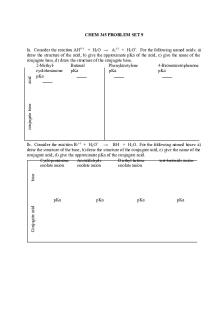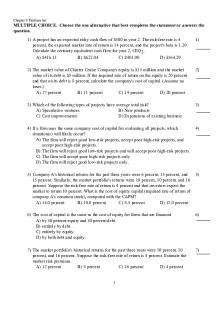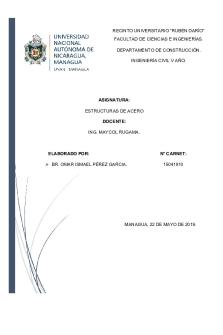SET 9 - Omar Eldakar PDF

| Title | SET 9 - Omar Eldakar |
|---|---|
| Course | Biology II/Lab |
| Institution | Nova Southeastern University |
| Pages | 9 |
| File Size | 70.1 KB |
| File Type | |
| Total Downloads | 62 |
| Total Views | 203 |
Summary
Omar Eldakar...
Description
SET 9 Population A group of individuals of a single species that occupy the same general area
Population Ecology Concerned with changes in population size and the factors that regulate populations over time. EX: Size, age, structure, growth rate
Population Density The number of individuals of a species per unit area or volume of the habitat...EX: The number of oak trees per square kilometer in a forest
Population Age structure The distribution of individuals in different age groups.
Life Tables Track survivorship, the chance of an individual in a given population surviving to various ages..used to predict how long, on average, a person of a given age will live.
Survivorship Curve A plot of the number of individuals still alive at each age in the maximum life span
Type 1 Survivorship The curve for the human population shows that most people survive to the older age intervals. *Humans and many other large mammals..usually produce few offspring, but gives them good care to survive to maturity
Type 2 Survivorship Survivorship is constant over the life span. *Intermediate meaning individuals are no more vulnerable at one stage of the life cycle than another
Type 3 Survivorship Low survivorship for the very young, followed by a period when survivorship is high for those few individuals who live to a certain age...*produce a lot of offspring but don't provide very good care for them..FISH
Life History The set of traits that affect an organisms schedule of reproduction and survival
Opportunistic life history One that enables the plant or animal to take immediate advantage of favorable conditions..EX: Dandelions
Equilibrial life history A pattern of developing and reaching sexual maternity slowly and producing few, well-cared offspring...larger bodied, longer living species..TYPE 1
Exponential Population Growth describes the expansion of a population in an ideal, unlimited environment. Explains how a few dozen rabbits can multiply to millions
Limiting Factors Environmental factors that restrict population growth. Ultimately control the number of individuals that can occupy an area
Population Size Fluctuates as new individuals are born, immigrate to a new area, emigrate away, and die
Carrying Capacity The max population size that a particular environment can sustain. Varies depending on species and resources available
Logistic Population Growth...the growth rate decreases as the pop size approaches carrying capacity
Density Dependent Factor Can limit growth in natural populations...may include limited food and territory
Intraspecific Competition The competition between individuals of same species for the same limited resources..Logistic model
Density independent factors A population limiting factor whose intensity is unrelated to pop density...Abiotic factors such as fires, floods, and storms.
Endangered Species One that is in danger of extinction
Threatened Species Those who are likely to become endangered in the future
Invasive Species An organism that causes ecological or economic harm in a new environment where it is not native.
Biological Control The intentional release of a natural enemy to attack a pest population...Eliminating or controlling troublesome pests
Integrated Pest Management
Crop scientists have developed this, strategies, and methods to deal with agricultural pests. Can combat invasive species as well
Human Population Growth An imbalance between births and deaths
Population momentum The increased proportion of women of childbearing age in the population
Prokaryotes are unlike all other organisms in that their cells: lack nuclei
Archaebacteria that live in oxygen free environments include: methanogens
Bacteria that contain chlorophyll a belong in the group: cyanobacteria
The process of converting nitrogen into a form plants can use is known as nitrogen: fixation
Bacteria reproduce asexually by: binary fission
Particles made up of nucleic acids, proteins, and in some cases, lipids that can reproduce only by infecting living cells are known as: viruses
The outer protein coat of a virus is a :
capsid
One group of viruses that contain RNA as their genetic information is: retroviruses
Disease-causing organisms are known as: pathogens
What are two distinguishing characteristics of prokaryotes? prokaryotes are the smallest and most common microorganism, they are single celled and lack a nucleus
Describe the three main cell shapes of prokaryotes: rod shaped bacilli spherical-shaped cocci corkscrew-shaped sprilli
How do scientists distinguish between Gram-positive and Gram-negative bacteria? Gram-positive: with a single cell wall layer absorb only the violet promary stain
Gram-negative: bacterial have a thin layer of peptidoglycan, this layer absorbs the red stain so the bacteria appear red
Describe two methods by which prokaryotes move: some don't move at all some move by flagella, some spiral forward, and some glide along on a slimelike material they secrete
How are photoautotrophs similiar to chemoautotrophs?
How are they different? they both make their own food photoautotrophs obtain energy from photosynthesis and depend on light chemoautotrophs obtain energy from hydrogen sulfide gas that flows from hydrothermal vents on the ocean floor
State one way in which photoheterotrophs are similiar to chemoheterotrophs: both use organic nutrients from the environment for nutritional needs
Distinguish between an obligate aerobe and an obligate anaerobe: obligate aerobes need constant oxygen obligate anaerobes do not require oxygen, and may be killed by oxygen
Faculative anaerobes can survive with or without oxygen. How is this advantageous to them? because they can live just about anywhere
What is the role of certain bacteria in changing atmospheric nitrogen into a form usable by plants? nitrogen fixation
What one characteristic do all viruses have in common? they enter living cells and once inside, use the machinery of the infected cell to produce more viruses (they can reproduce only by infecting living cells)
How is the capsid protein important to the functioning of a virus? the protein binds to receptors on the surface of a cell and trick the cell into allowing it inside then releases its viral genes
Describe the sequence of events that occur during a lytic infection:
a virus enters a cell makes copies of itself and causes the cell to burst
Describe what happens to the host cell of a lysogenic virus: the host cell makes copies of the virus indefinitely they do not lyse the host cell right away they remain inactive for a period of time.
What is the best way to protect humans against most viral diseases? prevention by using vaccines
How are viruses highly specific to the cells they infect? because viruses must bind precisely to proteins on the cell surface and then use a host's genetic system
Which of the following are NOT used to identify specific prokaryotes? size shape movement energy source Gram stain size
Which method is NOT used to protect food against microorganisms? salting freezing sterilization boiling vaccination
vaccination
Which illness is caused by a bacterium? AIDS polio diphtheria comhmon cold flu diphtheria
Which process is used for the exchange of genetic information between two bacterial cells? lytic cycle lysogenic cycle conjugation binary fission immunization conjugation
All bacteria are classified as: eukaryotes protists archaea prokaryotes blue-green algae prokaryotes
The larger of the two kingdoms of prokaryotes: eubacteria
they have cell walls made up of pepidoglycan
Archaebacteria do not contain _____________. The DNA sequence of key archaebacterial genes are more like those of eukaryotes than those of eubacteria. peptidoglycan
A typical virus is composed of a core of _____ or ______ surrounded by a protein coat. DNA RNA
Bacteria produce disease in one of two general ways. Damage cells and tissues by breaking down cells for food
Some release toxins
Name some ways to control bacterial growth: sterilization disinfection food processing
Viruses produce disease by disrupting the body's normal__________. equilibrium...
Similar Free PDFs

SET 9 - Omar Eldakar
- 9 Pages

SET 2 - Omar Eldakar
- 5 Pages

SET 4 - Omar Eldakar
- 5 Pages

Problem set 9 sheet
- 2 Pages

SET 9 - Mariam Harkas
- 7 Pages

Problem set 9 - Questions
- 3 Pages

SET 9 - Hauer
- 7 Pages

Problem Set 9-Solutions
- 6 Pages

Chapter 9 Problem Set
- 6 Pages

Problem Set 9 (Answers)
- 12 Pages

PHIL 130- question set 9
- 2 Pages

Set-9-solutions - tute solutions
- 4 Pages

Omar Perez Garcia
- 6 Pages

Private Study Questions Set 9
- 2 Pages

Articulo Edgar Omar (IMPC)
- 8 Pages
Popular Institutions
- Tinajero National High School - Annex
- Politeknik Caltex Riau
- Yokohama City University
- SGT University
- University of Al-Qadisiyah
- Divine Word College of Vigan
- Techniek College Rotterdam
- Universidade de Santiago
- Universiti Teknologi MARA Cawangan Johor Kampus Pasir Gudang
- Poltekkes Kemenkes Yogyakarta
- Baguio City National High School
- Colegio san marcos
- preparatoria uno
- Centro de Bachillerato Tecnológico Industrial y de Servicios No. 107
- Dalian Maritime University
- Quang Trung Secondary School
- Colegio Tecnológico en Informática
- Corporación Regional de Educación Superior
- Grupo CEDVA
- Dar Al Uloom University
- Centro de Estudios Preuniversitarios de la Universidad Nacional de Ingeniería
- 上智大学
- Aakash International School, Nuna Majara
- San Felipe Neri Catholic School
- Kang Chiao International School - New Taipei City
- Misamis Occidental National High School
- Institución Educativa Escuela Normal Juan Ladrilleros
- Kolehiyo ng Pantukan
- Batanes State College
- Instituto Continental
- Sekolah Menengah Kejuruan Kesehatan Kaltara (Tarakan)
- Colegio de La Inmaculada Concepcion - Cebu
